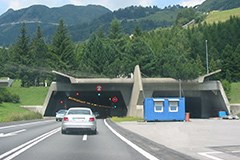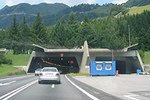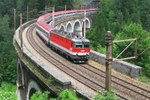News
New vehicle tunnels for goods traffic: a dead end
Jun 20, 2012
/
alpMedia
Traffic chaos in the Alps: this summer the most important transit axes are being closed to rail traffic. Haulage associations are thus again demanding new road tunnels. But the Alpine regions have decided that the solution to the traffic problem lies elsewhere.

Image caption:
Tunnel portal at the Gotthard: hauliers are demanding tubes in both directions. This will not increase safety, however, says the Swiss Advisory Board on Accident Prevention. © Grzegorz-Swiech/ wikimedia.org
Rail traffic through the Alps in late summer is to be heavily reduced or even halted. This is because the most important connections for goods traffic will be closed, with building works on the Lötschberg-Simplon section, the line blocked at Domodossola from mid-August to September and repairs at the Brenner Pass that will mean complete closure for 50 days, with no piggyback transport. Meanwhile, it is expected that no goods trains will cross the Gotthard, the most important Swiss transit route over the Alps, for a whole month owing to yet another rockslide. On the last occasion the motorway was also affected.
Gotthard and Fréjus: hauliers demand a second tube
This has resulted in the Canton of Tessin and the Swiss hauliers' association ASTAG once more demanding the immediate building of a second tube for the Gotthard autobahn tunnel. Coincidentally, at the same time the International Committee for the Monitoring of the Safety of the French-Italian Motorway Tunnels has announced the possible opening to regular traffic of the Fréjus safety tunnel. A project is being developed with this aim. Construction is due to last five years, after which it is intended that the Fréjus tunnel will be able to compete more effectively with the Mont Blanc tunnel. This could however mean an additional 600,000 trucks per year rumbling through Savoy, warn environmental organisations.
The frequently deployed argument that a second tube increases traffic safety has nevertheless been disproved by a recent study from the Swiss Advisory Board on Accident Prevention, at least as regards the Gotthard tunnel: "The extra traffic caused by a 3% (i.e. 500-vehicle per day) increase on two carriageways will negate the safety gain of a twin-tube tunnel".
Alpine regions: stronger policy for a modal shift to rail
Those Alpine regions affected by transit routes see things very differently from the hauliers. They have agreed to an active and ambitious policy to promote a modal shift to rail. In a resolution adopted in Lyon on 31 May, they call for rail traffic to become more attractive and more efficient. They also demand an Alpine transit exchange or an equivalent emissions exchange system. This should for example achieve a halving of truck journeys over the Brenner Pass by the year 2030. Currently two million trucks per year use the autobahn.
Source and further information:www.tt.com/%C3%9Cberblick/Politik (de), www.nzz.ch/aktuell/panorama (de), www.regione.piemonte.it/notizie (it), www3.lastampa.it/torino/sezioni/cronaca (it),www.imonitraf.org/DesktopModules (de/fr/it), www.bfu.ch/German/medien/Positionspapiere/PP (de)
Gotthard and Fréjus: hauliers demand a second tube
This has resulted in the Canton of Tessin and the Swiss hauliers' association ASTAG once more demanding the immediate building of a second tube for the Gotthard autobahn tunnel. Coincidentally, at the same time the International Committee for the Monitoring of the Safety of the French-Italian Motorway Tunnels has announced the possible opening to regular traffic of the Fréjus safety tunnel. A project is being developed with this aim. Construction is due to last five years, after which it is intended that the Fréjus tunnel will be able to compete more effectively with the Mont Blanc tunnel. This could however mean an additional 600,000 trucks per year rumbling through Savoy, warn environmental organisations.
The frequently deployed argument that a second tube increases traffic safety has nevertheless been disproved by a recent study from the Swiss Advisory Board on Accident Prevention, at least as regards the Gotthard tunnel: "The extra traffic caused by a 3% (i.e. 500-vehicle per day) increase on two carriageways will negate the safety gain of a twin-tube tunnel".
Alpine regions: stronger policy for a modal shift to rail
Those Alpine regions affected by transit routes see things very differently from the hauliers. They have agreed to an active and ambitious policy to promote a modal shift to rail. In a resolution adopted in Lyon on 31 May, they call for rail traffic to become more attractive and more efficient. They also demand an Alpine transit exchange or an equivalent emissions exchange system. This should for example achieve a halving of truck journeys over the Brenner Pass by the year 2030. Currently two million trucks per year use the autobahn.
Source and further information:www.tt.com/%C3%9Cberblick/Politik (de), www.nzz.ch/aktuell/panorama (de), www.regione.piemonte.it/notizie (it), www3.lastampa.it/torino/sezioni/cronaca (it),www.imonitraf.org/DesktopModules (de/fr/it), www.bfu.ch/German/medien/Positionspapiere/PP (de)



